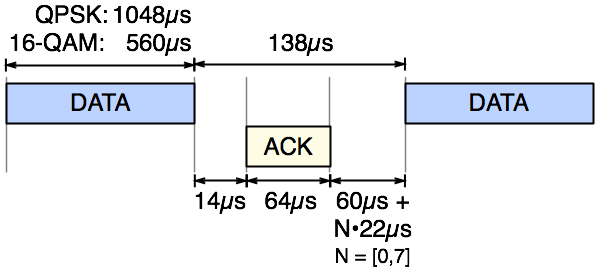| Version 2 (modified by murphpo, 14 years ago) (diff) |
|---|
OFDM Reference Design v14 - CSMA Benchmarks
Timing
The basic packet exchange which defines the maximum throughput for CSMA is DATA-ACK-DATA. The timing of this exchange is our implementation is illustrated below. Please note the figure is not drawn to scale.
This figure assumes the following parameters:
- SISO antenna configuration
- 2 OFDM symbols for channel training per packet
- 24 byte MAC header at QPSK (2 OFDM symbols)
- Full rate modulation of QPSK (12 bytes per OFDM symbol) or 16-QAM (24 bytes per OFDM symbol)
- 1484 byte payloads (1470 byte IP datagram + 14 byte Ethernet header)
This figure includes a random backoff period imposed after a node receives an ACK. This period is designed to prevent two fully-backlogged nodes from simultaneously attempting to transmit a new packet immediately after the previous DATA-ACK exchange completes. The backoff imposes a wait of an integral number of slot durations (a slot is 22µs in v14), with the slot count drawn randomly from [0,7].
Given this timing, the average minimum period for transmitting a new DATA packet is 1263µs (for QPSK full rate) or 775µs (for 16-QAM full rate), implying a peak data throughput of 9.31Mbps for QPSK and 15.2Mbps for 16-QAM.
Performance Tests
Peak Throughput
Methodology: two WARP Kits (SISO Kit v1), with radios connected via a cable and 60dB attenuation, FPGA boards each connected via Ethernet to a MacBook laptop. One MacBook runs an iperf server, the other runs the iperf client, using one of the following calls:
#For UDP tests: iperf -c 10.0.0.1 -u -b 20M -l 1470 -t 30 #For TCP tests: iperf -c 10.0.0.1 -l 1470 -t 30
Results:
| Full Rate | TCP | UDP |
| QPSK | XX | XX |
| 16-QAM | XX | XX |
